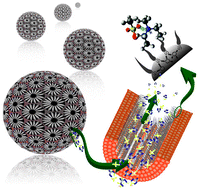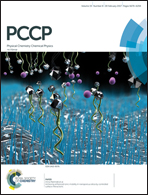Achieving enhanced ionic mobility in nanoporous silica by controlled surface interactions†
Abstract
We report a strategy to enhance the ionic mobility in an emerging class of gels, based on robust nanoporous silica micro-particles, by chemical functionalization of the silica surface. Two very different ionic liquids are used to fill the nano-pores of silica at varying pore filling factors, namely one aprotic imidazolium based (1-methyl-3-hexylimidazolium bis(trifluoromethanesulfonyl)imide, C6C1ImTFSI), and one protic ammonium based (diethylmethylammonium methanesulfonate, DEMAOMs) ionic liquid. Both these ionic liquids display higher ionic mobility when confined in functionalized silica as compared to untreated silica nano-pores, an improvement that is more pronounced at low pore filling factors (i.e. in the nano-sized pore domains) and observed in the whole temperature window investigated (i.e. from −10 to 140 °C). Solid-state NMR, diffusion NMR and dielectric spectroscopy concomitantly demonstrate this effect. The origin of this enhancement is explained in terms of weaker intermolecular interactions and a consequent flipped-ion effect at the silica interface strongly supported by 2D solid-state NMR experiments. The possibility to significantly enhance the ionic mobility by controlling the nature of surface interactions is extremely important in the field of materials science and highlights these structurally tunable gels as promising solid-like electrolytes for use in energy relevant devices. These include, but are not limited to, Li-ion batteries and proton exchange membrane (PEM) fuel cells.



 Please wait while we load your content...
Please wait while we load your content...